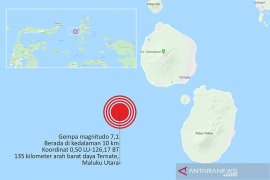Ambon, Maluku (ANTARA) - The Maluku provincial administration has extended the emergency response period for the recent powerful earthquake from September 26 to October 9 to enable the authorities to distribute humanitarian aids to survivors in all affected areas.
"We must extend the emergency response period for two more weeks by considering the ongoing distribution of humanitarian aids to all affected areas and incomplete data on those affected by this 6.5-magnitude quake," Head of the Maluku Disaster Mitigation Agency (BPBD) Farida Salampessy said.
Speaking to ANTARA in Ambon on Sunday, she said several displaced people currently taking refuge at temporary shelters in remote areas still complained that they did not receive sufficient health services and humanitarian packages.
Related news: Ambon quake wrecks 171 houses in its path
Due to the fact that the number of humanitarian workers and volunteers remain limited to reach the refugees at all affected areas, the provincial government decided to extend the emergency response period, Farida Salampessy said.
At the moment, some 95,256 displaced people are taking refuge in which majority of them are being accommodated at temporary shelters in the districts of Maluku Tengah and Western Seram (SBB).
The 6.5-magnitude quake that rocked Ambon Province on September 26 also killed 38 people and wounded 27 residents in Ambon city, 90 residents in Maluku Tengah District, and 32 residents in Western Seram District, she said.
Due to the trauma and anxiety that local residents still experience in the aftermath of this powerful earthquake, the BMKG recently cautioned Maluku Province residents not to believe in rumors, fake news, and misleading information on a powerful earthquake and tsunami that could jolt Ambon, Masohi, and Banda.
The Meteorology, Climatology, and Geophysics Agency (BMKG) argued that no one could precisely predict when and where the earthquakes would occur.
Regarding the impact of this recent powerful earthquake, the National Disaster Mitigation Agency (BNPB) recorded that it damaged several buildings of Pattimura University were damaged.
Located on the Circum-Pacific Belt, also known as the Ring of Fire, where several tectonic plates meet and cause frequent volcanic and seismic activities. Indonesia is susceptible to natural disasters, including earthquakes and volcanic eruptions.
During 2018, the BMKG recorded that Indonesia had borne the impact of 11,577 earthquakes, including several causing grave casualties, with the number significantly rising than that in 2017.
Related news: Ambon struck by 6.5-magnitude earthquake
The BMKG data showed that 11,577 earthquakes, with varying magnitudes and depths, hit during 2018, while just 7,172 earthquakes were recorded in 2017.
This indicates that Indonesia bore witness to a significant increase in the number of tectonic earthquakes last year.
Several earthquake-related events that had struck Indonesia last year were first of a kind to have occurred, such as the liquefaction in Palu, a tsunami that struck prior to the issuance of a tsunami warning in Palu, and the Sunda Strait Tsunami.
Related news: Jokowi dispatches humanitarian aid to Ambon, Wamena
Related news: Don't believe quake, tsunami rumors, Maluku's residents urged









